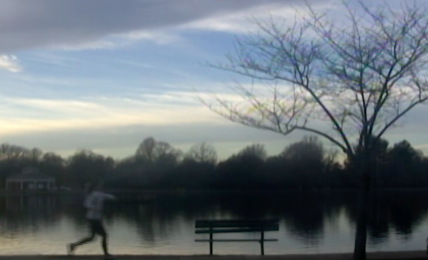Dalena Tran explores the unique soundscape created between two cities in her visually moving and auditorily stimulating creation Acts in Translation (2020). Thirty-seven cities provide eighty separate recordings which are randomly generated and paired to create a new ambient recording with every individual site visit. There are two-thousand nine-hundred and sixty possible recording combinations of paired cities that a viewer might experience. Upon entering the webpage, an image appears of two long, open windows, with blue-painted frames, built into a burnt orange stucco wall. The wall remains stable, with only the slight breeze on the window curtains and flickering light to catch your eye and indicate movement. As you gaze into the mysterious and intimate rooms beyond, interesting sounds become discernible. Sounds range from murmuring voices to chirping birds to the sound of taxi-cabs honking. These authentic moments, overlapped into imaginary sound worlds, entrance listeners, who stare at the image of the windows, but are unseeing as they get lost in immersive soundscapes that seem to come from beyond the window frames. All the while a digital clock at the bottom of the screen counts down the minutes until “the story begins.” The wait, sometimes long, sometimes short, but determinedly frustrating, builds curiosity and suspense. Listeners are forced to address, ponder, and visualize the interplaying tones and rhythms which create “urban imaginaries” that are interesting enough to capture and hold attention during the tantalizing wait.
Tran challenges our user instinct for instant click and instant reward by embedding a narrative story into the site, which will only begin at the start of every hour. This structured release, so unusual for internet art, universalizes the viewing experience. Audiences alike, from every corner of the globe, must wait until the next hour strikes to hear the story from the beginning. Depending on what time a viewer first clicks on the site, the promise of a scheduled story is likely to bring them back to the piece again, therefore stretching their experiences with the piece even further. While they wait, Tran invites viewers to “feel free to stay awhile.” Meanwhile, the continuous image of a window curtain blowing in the virtual breeze is reminiscent of a stage curtain, waiting to be opened, as the clock counts down to showtime. On my first visit, there were forty minutes left on the countdown clock. I decided to come back right before the story began. On my second visit, fifteen minutes remained on the clock. Instead of clicking out and coming back in a quarter of an hour, I decided to stick with the piece. I was able to sit with the soundscape and really take it in before the narration began. This prolonged listening experience added to my understanding of and appreciation for the different layers of sound behind the narration. I was able to visualize a stimulating and fully-realized setting in which this story was spoken. The story, a personal narrative, spoken by a woman in a duly emotive yet seemingly computer-generated-esque voice, revisits her experiences and lessons learned of a broken heart. Operating as an “entendre” underscores the complexity of different cultural perceptions but the universality of language. This story becomes an individual experience for each viewer as their own uniquely generated soundscape complements and contrasts in the background. Through committed time and engagement listeners are rewarded with a completely unreplicable experience as the fruit of their labors.
Guangzhou, China converses with Seoul, South Korea; Calgary, Canada with Sofia Bulgaria; Tehran, Iran with Philadelphia, USA. Two windows open up a world in which two entirely foreign cities have a direct conversation with each other. The sounds blend into one, at times complementing each other and other times sounding at odds. In Stockport, England, and Riga, Latvia the melodic chirping of birds overlaid with sounds of quick typing on a keyboard, and a crying baby can be heard in conversation. These conversations begin to challenge our global perceptions, quick-witted assumptions, and stereotypical beliefs. It can be difficult to discern between sounds but easy to assign the characteristics to one of the two cities based on our preconceived notions about different cultures. Audiences can contemplate the continuities and juxtapositions of urban life and what it actually sounds like around the world. The experience includes listening to both the welcomed familiar but also the unnerving unnatural, which comes from mixing unrelated sounds, through nonetheless enchanting auditory immersion.
Tran questions our universal perception and retention of everyday life by “dislocating” and “defamiliarizing” listeners from what they know. As the global pandemic limited human mobility, life became increasingly confined to domestic spaces. Work, leisure, celebration, and interaction all became home-based. In this increasingly technological and communication-focused world, Tran invites visitors to take a step back and to pay attention to the unique moments and beautiful potential that life offers us every day, but that we often lose sight of in our oversaturated environment.
:::

Ali Mills is a sophomore at the University of Richmond studying Art History and Visual Arts. She enjoys traveling, visiting local art galleries and museums in Washington, D.C. and spending time with friends and family.



